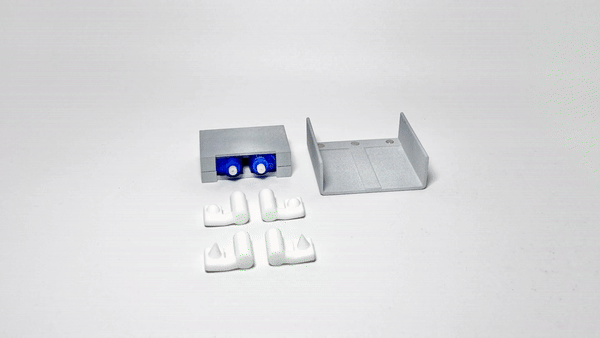TacTag- Tactile Feedback Prototype Toolkit
Lang Qin
Advisor: Kari Love
The TacTag Toolkit provides haptic interface designers with modular hardware and a web GUI for innovation. It streamlines the creation and testing of tactile sensations, offering six default sensations, including squeezing, tapping, and rubbing. Designers can interchange modules and customize patterns through the web GUI to discover more sensations, enhancing early design development and facilitating remote collaboration.

Abstract
In the era of information overload, the TacTag Toolkit stands out as an innovative, wireless solution for haptic interface designers facing the challenges of testing and obtaining feedback in the burgeoning field of tactile interfaces. This project was inspired by the everyday bombardment of data and the need for more discreet and direct notification methods that respect privacy and accessibility, not only for the visually and hearing impaired but also for general audiences.
TacTag serves as a versatile toolkit for the discovery of a diverse palette of tactile sensations, such as tapping, squeezing, trembling, shaking, rubbing, and vibrating. These sensations facilitate intuitive user interactions independent of sight or sound. The kit includes a wearable, IoT-enabled modular gadget with two mechanical modules and four pairs of tactor modules. This hardware array, combined with a specialized web GUI, allows for streamlined control, easy modification, and efficient data management, significantly speeding up the prototyping process. The toolkit is pre-configured with six standard sensations and grants designers the flexibility to swap out modules and tailor patterns through the web GUI to create additional sensations.
TacTag's ambition is to simplify the design journey, alleviate designers' workloads, and foster seamless remote collaboration from the get-go. By providing a deeper comprehension of tactile feedback, the TacTag Toolkit not only advances haptic interface development but also pioneers future communication technologies reliant on touch.

Technical Details
The toolkit includes an IoT wearable device composed of two types of servo components and tactors to support six default tactile interactions. The accompanying web GUI empowers designers to manage hardware, customize data, and log interaction details.
• Arduino
• JavaScript
1. IoT Structure: The toolkit is designed with IoT architecture, enabling wireless communication between the hardware and web GUI through MQTT, powered by a battery.
2. Customization: Recognizing individual differences in tactile perception, the TacTag provides default sensations while allowing designers to adjust parameters like distance, speed, and frequency via the web GUI to create bespoke tactile experiences. This user-friendly interface requires no programming skills, making it accessible for designers to control the hardware effortlessly and build their own solutions.
3. Data Storage: The web GUI features capabilities for recording and saving customized data settings, which can be retrieved and utilized for future use, streamlining the iterative design process.
4. Merge and Apply: The web GUI is enhanced with 'merge and apply' functionalities to cater to a wide array of sensation requirements, enabling designers to layer multiple sensations and create complex tactile patterns.
5. Modular Hardware: The TacTag's modular design, facilitated by magnetic connectors, promotes flexibility and portability. This modular approach not only simplifies the prototyping process but also supports the lightweight and compact nature of the hardware for ease of use and installation.
6. Easy-to-Install Device: The device is designed for wearability, comfortably fitting on the forearm or calf. This aspect of the design ensures that the TacTag can be used seamlessly in various scenarios, from active settings like exercising to more static situations such as working at a desk.

Research/Context
Drawing on my background in the financial sector, where the critical exchange of monetary information is paramount, I’ve identified a limitation in the way we interact with such vital data. Current methods—visual and auditory notifications—are ubiquitous, but they often fall short in terms of privacy and immediacy, especially in contexts where timely and confidential interaction is essential, like finance, health status, information security, and secrets. Tactility offers a direct, private channel for such communication.
With the TacTag Toolkit, I aim to empower haptic designers to explore a richer spectrum of touch-based perceptions. Today's technology relies heavily on vibration, overlooking the vast potential of tactile experiences. Moreover, traditional tactile devices are typically bulky, which complicates testing. TacTag overcomes these issues by providing a discreet, rapid way to communicate through tactility. It’s not just a tool; it's a more humane, effortless, and notably lightweight solution, encouraging end-users to focus more on the tactile experience itself and comfortably wear and test it in various everyday situations.
TacTag's novelty is its wireless IoT structure and versatile hardware, paired with an easy-to-use web GUI. This setup allows for crafting and customizing tactile sensations without complex coding. It's designed not just to simplify the creative process and cut down on grunt work but also to let designers customize tactile experiences for users' unique needs and even to merge and apply a series of tactile sensations for richer exploration—something out of reach with current methods.
TacTag's impact could stretch well beyond the design world. If it takes off, it promises to reshape user interaction in multiple features and scenarios, offering a way of communication that's both inclusive and adaptable. For instance, a joyful tremble for earning money or a sudden squeeze to signal significant expenditure. Moreover, it stands to change how people with sensory challenges use technology, secure sensitive exchanges, and push the boundaries of immersive tech experiences. A bolder vision posits that tactile sensation could evolve into an independent language system, fostering greater confidence in autonomy and access.
If you're excited about the future of tactile communication, let's team up. I'm looking for partners to help push this technology forward. Join me in shaping how we feel about the digital world.
